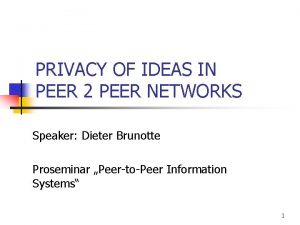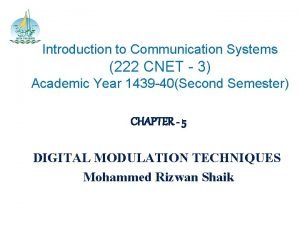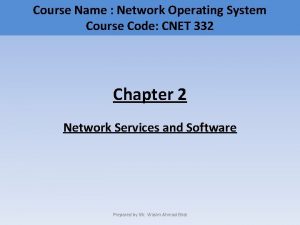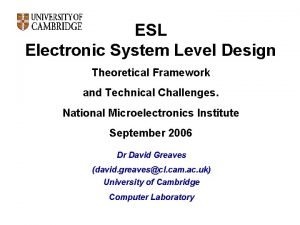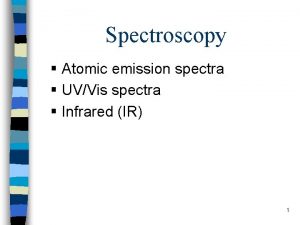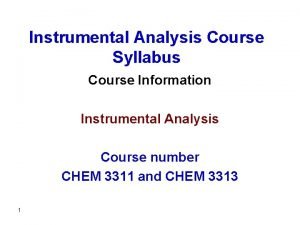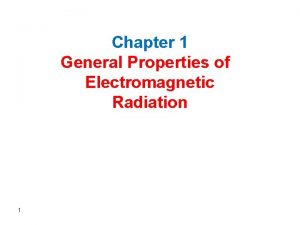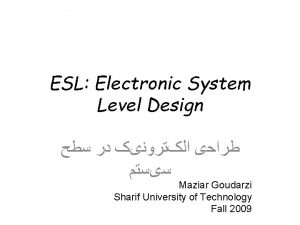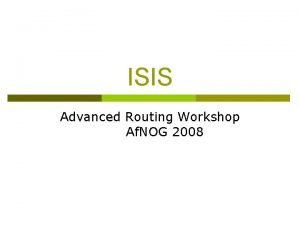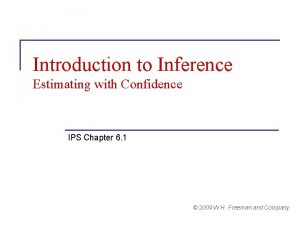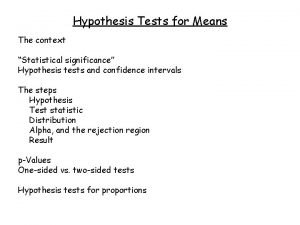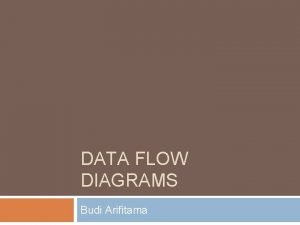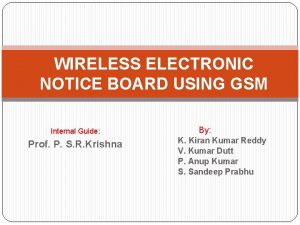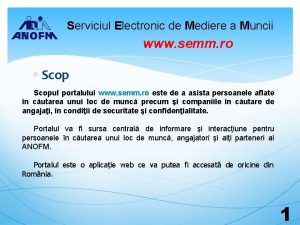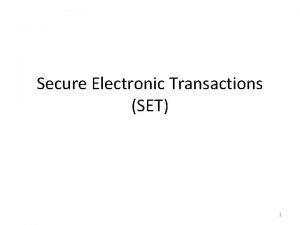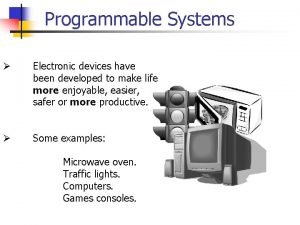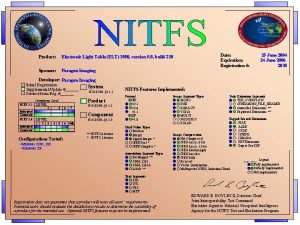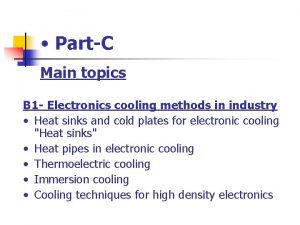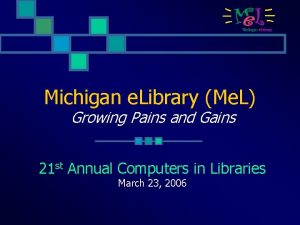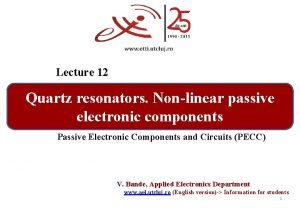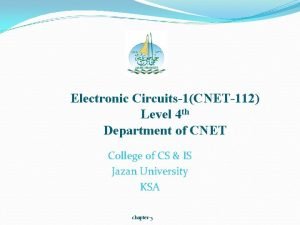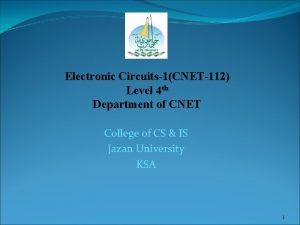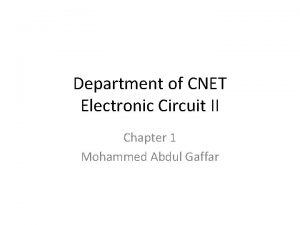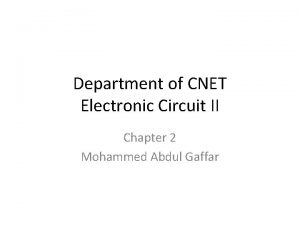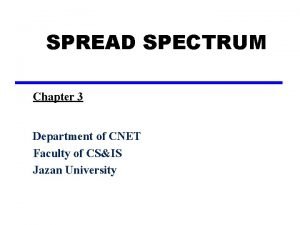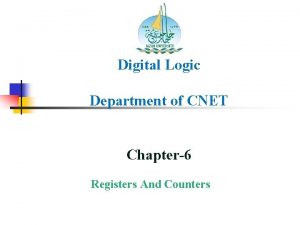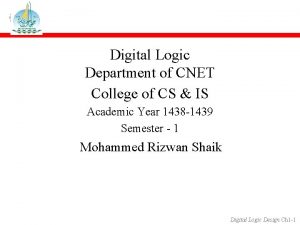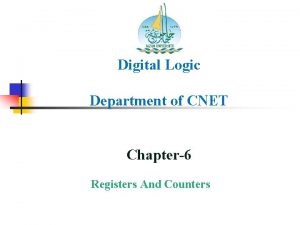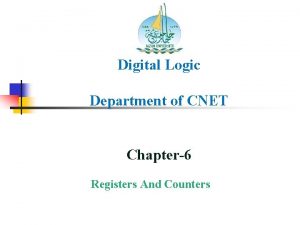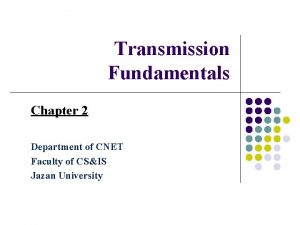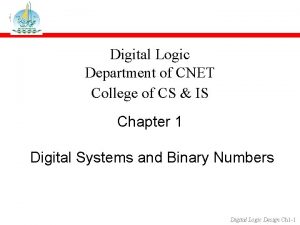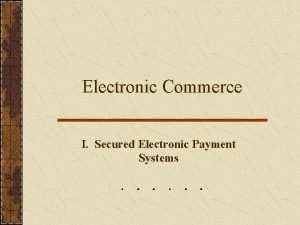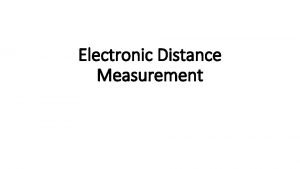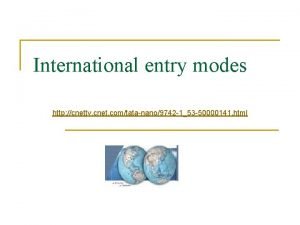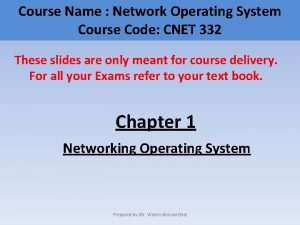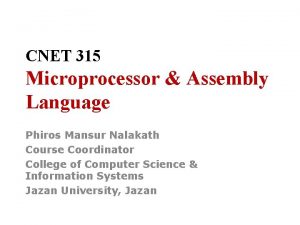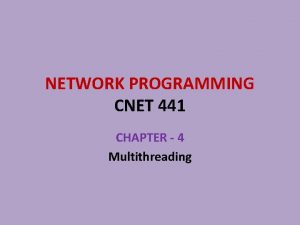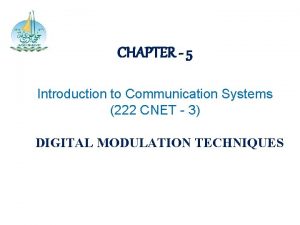Electronic Circuits1CNET112 Level 4 th Department of CNET














































- Slides: 46

Electronic Circuits-1(CNET-112) Level 4 th Department of CNET College of CS & IS Jazan University KSA

CHAPTER -4 APPLICATIONS OF DIODE Objectives In this Chapter, student will learn the following topics: Ø Half Wave Rectifier Ø Peak Inverse Voltage Ø Center-Tapped Transformer Rectifier Ø Bridge Rectifier Ø Clippers (Biased & Parallel) and Clampers Ø Voltage-Multiplier Circuits (Voltage Tripler and Quadrupler)

Rectifier It’s a circuit which is used to convert AC into DC. Half-Wave Rectifier The diode only conducts when it is forward biased, therefore only half of the AC cycle passes through the diode to the output.


The DC output voltage is 0. 318 Vm, where Vm = the peak AC voltage.

Half-Wave Rectifier

Half-Wave Rectifier (Video)

• PIV (PRV) • Because the diode is only forward biased for one-half of the AC cycle, it is also reverse biased for one-half cycle. • It is important that the reverse breakdown voltage rating of the diode be high enough to withstand the peak, reverse-biasing AC voltage. – PIV (or PRV) > Vm PIV = Peak inverse voltage PRV = Peak reverse voltage Vm = Peak AC voltage


• Full-Wave Rectification • The rectification process can be improved by using a fullwave rectifier circuit. • Full-wave rectification produces a greater DC output: • • Half-wave: Vdc = 0. 318 Vm Full-wave: Vdc = 0. 636 Vm


Full-Wave Rectification 1. Center-Tapped Transformer Rectifier • Requires • Two diodes • Center-tapped transformer • VDC = 0. 636 Vm


Full-Wave Rectification During Positive And Negative Cycle



Full-Wave Rectification Bridge Rectifier • Four diodes are connected in a bridge configuration • VDC = 0. 636 Vm

Full-Wave Rectification During Positive And Negative Cycle



Bridge Rectifier (Video)

Summary of Rectifier Circuits Rectifier Ideal VDC Realistic VDC Half Wave Rectifier VDC = 0. 318 Vm – 0. 7 Bridge Rectifier VDC = 0. 636 Vm – 2(0. 7 V) Center-Tapped Transformer Rectifier VDC = 0. 636 Vm – 0. 7 V • Vm = peak of the AC voltage. • In the center tapped transformer rectifier circuit, the peak AC voltage is the transformer secondary voltage to the tap.


Diode Clippers • The diode in a series clipper “clips” any voltage that does not forward bias it: • A reverse-biasing polarity • A forward-biasing polarity less • than 0. 7 V (for a silicon diode)


Biased Clippers • Adding a DC source in series with the clipping diode changes the effective Forward bias of the diode.


Parallel Clippers • The diode in a parallel clipper circuit “clips” any voltage that forward bias it. • DC biasing can be added in series with the diode to change the clipping level.


Summary of Clipper Circuits

Summary of Clipper Circuits

Introduction To Clippers (Video)

Clampers A diode and capacitor can be combined to “clamp” an AC signal to a specific DC level.

Biased Clamper Circuits • The input signal can be any type of waveform such as sine, square, and triangle waves. • The DC source lets you • adjust the DC camping level.


Summary of Clamper Circuits

Introduction to Clampers (Video)

Voltage-Multiplier Circuits Voltage multiplier circuits use a combination of diodes and capacitors to step up the output voltage of rectifier circuits. • Voltage Doubler • Voltage Tripler • Voltage Quadrupler


Voltage Doubler This half-wave voltage doubler’s output can be calculated by: Vout = VC 2 = 2 Vm where Vm = peak secondary voltage of the transformer

Voltage Doubler • Positive Half-Cycle o D 1 conducts o D 2 is switched off o Capacitor C 1 charges to Vm • Negative Half-Cycle o D 1 is switched off o D 2 conducts o Capacitor C 2 charges to Vm Vout = VC 2 = 2 Vm

Voltage Tripler and Quadrupler

Voltage Multiplier Video

Practical Applications • Rectifier Circuits – Conversions of AC to DC for DC operated circuits – Battery Charging Circuits • Simple Diode Circuits – Protective Circuits against – Overcurrent – Polarity Reversal – Currents caused by an inductive kick in a relay circuit • Zenar Circuits – Overvoltage Protection – Setting Reference Voltages – Voltage regulator.


Queries
 Cnet3
Cnet3 Ecommerce content syndication
Ecommerce content syndication Cnet
Cnet Cnet communication
Cnet communication Cnet ftp
Cnet ftp An electronic is the electronic exchange of money or scrip
An electronic is the electronic exchange of money or scrip Electronic field production examples
Electronic field production examples System-level design
System-level design Uv vs ir
Uv vs ir Electronic energy level
Electronic energy level Electronic energy level
Electronic energy level Electronic system level design
Electronic system level design Molecular level vs cellular level
Molecular level vs cellular level Isis protocol
Isis protocol Confidence level and significance level
Confidence level and significance level Isis level 1 vs level 2
Isis level 1 vs level 2 Significance level and confidence level
Significance level and confidence level Confidence level and significance level
Confidence level and significance level Level 0 dfd
Level 0 dfd Piramida level keamanan informasi memiliki berapa level
Piramida level keamanan informasi memiliki berapa level What is a level three question
What is a level three question Thread level parallelism in computer architecture
Thread level parallelism in computer architecture Rcp hlsl
Rcp hlsl Pfp courses cut off points
Pfp courses cut off points Wireless electronic notice board using gsm
Wireless electronic notice board using gsm Electronic copyright office
Electronic copyright office Bathochromic shift and hypsochromic shift
Bathochromic shift and hypsochromic shift Stable electron configurations
Stable electron configurations Patent electronic business center
Patent electronic business center Legal environment of e commerce
Legal environment of e commerce Electronic service manuals
Electronic service manuals My sonitrol
My sonitrol Electronic toe load measuring device
Electronic toe load measuring device Aadr contact
Aadr contact Serviciul electronic de mediere a muncii
Serviciul electronic de mediere a muncii Features of secure electronic transaction
Features of secure electronic transaction Royal electronic factory
Royal electronic factory Programmable electronic devices
Programmable electronic devices Electronic light table
Electronic light table Principles of electronic communication systems 3rd edition
Principles of electronic communication systems 3rd edition Portable electronic maintenance aid
Portable electronic maintenance aid Electronic cooling methods
Electronic cooling methods Electronic media definition
Electronic media definition Electronic configuration of oxygen
Electronic configuration of oxygen Michigan electronic library
Michigan electronic library Mesaj electronic exemplu
Mesaj electronic exemplu Nonlinear electronic components
Nonlinear electronic components


